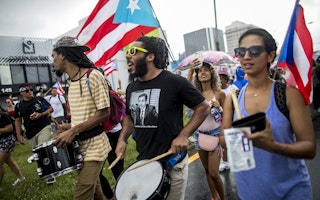Affirmative Action’s True Purpose
By Sherrilyn Ifill
This piece first appeared on The Root.
As the Supreme Court prepares to hear oral arguments this week in Fisher v. University of Texas, we can expect our country to descend into the now standard hand-wringing about affirmative action. But our conversations about Fisher, like those surrounding the Ricci v. DeStefano firefighter case four years ago and the Grutter v. Bollinger case nine years ago, will most likely avoid engaging the core questions that lie at the heart of whether and how affirmative action should be continued.
The blame for the inadequate nature of our conversation about affirmative action must be shared by civil rights organizations and right-wing groups. In the late '70s and early '80s, when right-wing groups and the Reagan Justice Department were engaged in a full-frontal attack on affirmative action, civil rights organizations were hard at work fighting the toughest cases in the courts. What civil rights organizations were not doing was fighting the right on the terrain of America's hearts and minds. Of course, civil rights leaders thought that they had fought that battle already. The civil rights movement was not just a monumental legal and legislative victory over institutionalized racism in the United States; it was also—and perhaps more importantly—a moral victory over the idea of white supremacy.
Forty years later, overt racism remains a social taboo, largely because of the shifted moral ground plowed by civil rights protesters, plantiffs, schoolchildren and iconic leaders, who compelled America to confront itself and shamed this country into living up to our country's rhetoric about freedom and equality.
But it's now evident that during the late ’70s and ’80s we mistakenly abandoned the moral appeal to the heart of America. Instead, the right took up their own emotional and moral appeal. They spoke to deeply held American beliefs about fairness, and the ill-informed belief that America is a true meritocracy. And they tapped into the fierce underlying fear and insecurity of working-class whites, who feared that black advancement would result in their economic displacement.
By the time the Supreme Court had the opportunity to rule on the constitutionality of affirmative-action policies, the court and the American public were already deeply influenced by an anti-affirmative-action lexicon that had begun to seep into the mainstream. The word “quota” had been resurrected and mined for all of its anti-Semitic history and used to taint affirmative-action efforts. The term “reverse discrimination”—a slur against affirmative action in the ’80s—became mainstream and was, by the 1990s, the title of sections in constitutional-law casebooks used to teach the nation's law students.
For the last 20 years, affirmative action has suffered even more by the limited context in which it's been considered by the court and the public. Admission to elite universities and law schools has masked the realities of continued racial exclusion and segregation in employment in the U.S. economy, where, from its very beginnings, affirmative-action efforts have been powerfully resisted. The result is that even many blacks believe that affirmative action has nothing to do with working-class blacks. The Ricci v. DeStefano case, in which a bare majority of the court struck down the use of affirmative-action measures in the assessment of firefighter exams, provided at least some opportunity to talk about racial exclusion in fire departments throughout the United States.
In fact, despite affirmative-action requirements issued in the early 1970s by state and local governments, the doors to working-class, secure jobs remained closed for African Americans and women of all races in key employment sectors that rely on government contracts and work. One reason is the limits imposed by the Supreme Court in a series of cases. But perhaps more important is the resistance by the industries themselves to diversifying the workplace. Whether it was the construction trades, electrical unions or fire departments, white organized-labor groups and public-employees groups resisted affirmative-action plans that might have resulted in real workplace diversity and long-term economic security for working-class women and blacks.
The resistance in some areas continues. Just this year, the longshoremen’s union in New York refused to comply with a plan advanced by New York harbor's waterfront commission to promote diversity among dockworkers.
One consequence of the failure to engage the public's imagination and moral core in advancing affirmative action is that when anti-affirmative activists like Ward Connerly took the question of affirmative action out of the courts and directly to the people through ballot initiatives, affirmative action suffered yet another blow. Belatedly we learned that even a conservative Supreme Court can be more liberal on race than a majority of the electorate.
The result is that affirmative action, which initially promised transformative returns for working-class women and minorities in jurisdictions across the United States, was successfully undermined, even as we devoted disproportionate attention to affirmative action in university admissions. Today, with the U.S. economy in continued peril, and with the strongest threats to public-sector jobs as well to construction and other infrastructure employment, the chances for a renewed commitment to affirmative action in employment is slim.
Which brings us to the Supreme Court's consideration of the Fisher case this term. Unlike employment, higher education is the one area in which affirmative action has been largely successful. Thousands of minority students have benefited from the commitment of universities and professional schools to create a diverse student body. Equally, white students and institutions have benefited from the presence of minority students, whose perspectives, experiences and intellectual contributions have invigorated discourse, provided exposure to important aspects of American life and helped incubate a multiracial class of leaders in the nation that was unimaginable 50 years ago.
The stage may be set for the five-member conservative majority on the court to imperil the ongoing vitality of affirmative action. Chief Justice John Roberts, who, in opposing the modest, voluntary public-school affirmative-action plan in Parents Involved in Community Schools v. Seattle, famously said (pdf), “the way to stop discrimination based on race is to stop discriminating based on race,” could not have crafted a better context in which to announce further limits on affirmative action. With a weak economy resulting in little inclination among working-class to promote efforts to “share the pie” and a black president who is disinclined to talk publicly about race, the climate may never be better for the court to turn its back on affirmative action.
But whatever course the court takes, it remains up to civil rights advocates to find a way to begin a renewed conversation about race and affirmative action—one that respects the legitimate fears of whites struggling in an unforgiving economy, but that reminds us why affirmative action is an investment in the future of a better America for all of us.
Sherrilyn Ifill is the seventh president and director-counsel of the NAACP Legal Defense and Educational Fund (LDF).


